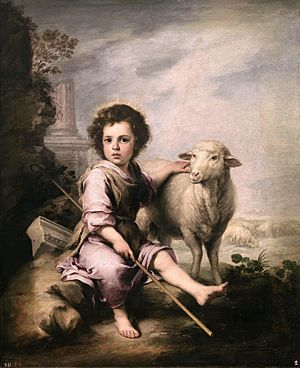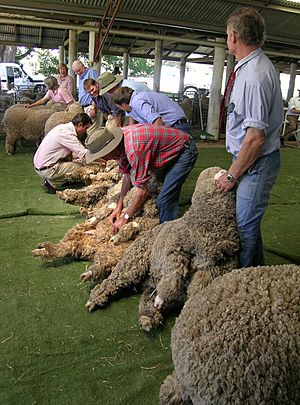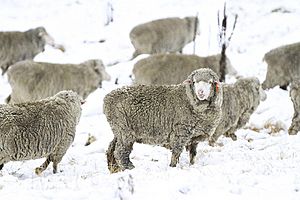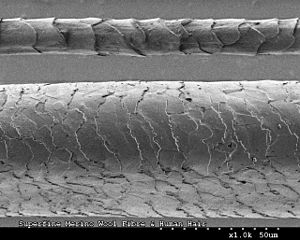Merino facts for kids
The Merino is a special type of domestic sheep known for its super soft and fine wool. This breed first appeared in Spain around the end of the Middle Ages. For several centuries, Spain kept Merinos a secret, making it illegal to export them. Anyone caught trying to take them out of the country faced very serious consequences.
In the 1700s, some Merino sheep were sent to royal families in other European countries like France, Hungary, and Germany. From there, Merinos spread to many parts of the world, including Australia and New Zealand. Today, there are many different types of Merino sheep, such as the Australian Merino and the Rambouillet.
Some Merino sheep, like the Australian Poll Merino, don't have horns. Male Merinos (rams) of other types usually have long, curly horns, while the females (ewes) are typically hornless.
The Story of Merino Sheep

What Does "Merino" Mean?
The name merino first appeared in Spain in the early 1400s, and its exact meaning is still debated.
One idea is that the name came from a Spanish official called a merino. This official might have checked on sheep pastures. The word merino comes from a Latin word meaning "greater" or "head official."
Another idea is that the name came from a North African tribe called the Marini. This tribe lived in parts of Spain in the 1100s and 1200s. Many old Spanish words about farming come from Arabic or Berber languages. However, most experts believe Merino sheep developed much later than when this tribe was in Spain.
Where Did Merinos Come From?
There are a few ideas about how Merino sheep first appeared in Spain:
- Some think they were brought from North Africa in the 1100s.
- Others believe they developed and improved in Spain during the 1100s and 1200s.
- A third idea, which is supported by recent studies, suggests that Merinos were created in Spain over many centuries. This happened by mixing Spanish ewes with rams from different places, like Italy, North Africa, and England. This means their super fine wool didn't fully develop until the 1400s or even later.
Before the 1400s, Spain mostly exported wool used for cheaper clothes. But by the late 1400s, Spanish wool became famous for its fine quality. By the mid-1500s, Merino wool was considered as good as the best English wool.
Spain gained a strong hold on exporting fine wool in the late 1400s and 1500s. This brought a lot of money to the region of Castile.
Many Merino flocks in Spain belonged to rich families or the church. These sheep would travel long distances each year, grazing in southern Spain in winter and northern Spain in summer. This annual journey was managed by a group called the Mesta. They made sure the sheep had good paths, water, and places to rest.
Three main types of Merino sheep started most of the world's Merino flocks: the Royal Escurial, the Negretti, and the Paula. Today, some European Merino breeds are becoming rare, but the Merino sheep has spread all over the world.
Merinos Go Global
Before the 1700s, taking Merinos out of Spain was a crime that could cost you your life! But in the 1700s, small numbers of Merinos were finally allowed to leave Spain.
- In 1723, some went to Sweden.
- In 1765, the King of Spain sent some to Germany. More went to Hungary in 1775 and Prussia in 1786.
- In 1786, the King of France received 366 Merinos, which started a famous sheep farm in France called Rambouillet.
These French Rambouillet sheep later had a huge impact on the Australian Merino. One special ram named Emperor, brought to Australia in 1860, helped shape the Australian Merino breed.
In 1787, Sir Joseph Banks managed to get two rams and four ewes for King George III of England. These sheep started the royal flock in England.
In 1790, the King of Spain also gave some Merinos to the Dutch government. These sheep did well in South Africa. In 1788, John MacArthur brought Merinos from South Africa to Australia.
From 1765, German breeders in Saxony mixed Spanish Merinos with local sheep. They created a very fine and dense type of Merino wool. By 1802, Germany was known for having some of the finest wool in the world.
In 1802, Colonel David Humphreys brought Merinos to North America. During the war between Britain and the U.S. (1812), there was a "Merino Craze" because wool was in high demand.
The Napoleonic Wars (1793–1813) almost destroyed the Merino industry in Spain. After these wars, Germany, the United States, and Australia became the main places for Merino breeding.
Merinos in the United States
Merino sheep arrived in Vermont in 1802. This led to a big boom in wool prices, but then the prices dropped. Vermont couldn't compete with other states, and sheep farming there declined.
Merinos in Australia
Early Days
When the First Fleet arrived in Australia in 1788, only about 70 native sheep survived the trip. These sheep were only good for meat. A few months later, the flock had shrunk to just 28 ewes and one lamb.
In 1797, some important people bought sheep in South Africa and brought them to Australia. These early Merinos came from different places like South Africa, England, and France. Even though they came from various sources, Australian Merino sheep today are genetically similar and unique.
John and Elizabeth Macarthur
By 1810, Australia had over 33,000 sheep. John MacArthur is often called the "father of the Australian Merino industry." He brought seven rams and one ewe from King George III's sheep sale in 1804. His wife, Elizabeth, had been taking care of their sheep while he was away.
MacArthur also brought Saxon Merinos to Australia in 1812. The first big wool boom in Australia happened in 1813. In the 1820s, more people became interested in Merino sheep.
Eliza and John Furlong
Eliza Furlong (sometimes spelled Forlong or Forlonge) was a determined woman. She wanted her sons to have outdoor jobs in a warm place because her other children had gotten sick. Her husband, John, noticed that wool from Germany sold for much more than wool from Australia. So, they decided to start a sheep farm in Australia.
In 1826, Eliza walked over 1,500 miles (2,400 km) through Germany, choosing the best Saxon Merino sheep. Her sons studied sheep breeding. They took 100 sheep to Hamburg, then by ship to England, and then walked them to Scotland for another ship to Australia. Eliza made this trip three times! Her sons went to Australia with the sheep, stopping in Tasmania where Eliza and her husband later joined them.
Eliza Furlong was praised in a newspaper in 1908 for helping to make an entire state successful.
The Peppin Brothers
The Peppin brothers had a different idea for creating a stronger, broader-wool sheep. They bought a farm called Wanganella Station. They chose 200 local ewes that did well in the area and bought 100 ewes from South Australia. They mostly used Saxon and Rambouillet rams. One of their rams, named Emperor, produced a lot of wool. The Peppin and Murray sheep types became very popular in Australia.
Vermont Merinos in Australia
In the 1880s, Vermont rams were brought to Australia from the U.S. Many Australian sheep farmers thought these sheep would produce more wool. However, while the Vermont sheep had heavy fleeces, the wool wasn't always the best quality. It also had more grease, which could lead to problems like flystrike. This caused problems for many fine-wool farms.
The Federation Drought (1901–1903) greatly reduced the number of sheep in Australia and ended the "Vermont era."
High Price Records
The highest price ever paid for a Merino ram was A$450,000 in 1988! In 2008, an Australian Merino ewe sold for A$14,000.
Merino Events
The New England Merino Field Days happen every two years in January. They show off local sheep farms, wool, and sheep. The Annual Wool Fashion Awards are held in March each year in Armidale. These awards highlight how fashion designers use Merino wool.
Looking After Merinos
In Australia, a practice called mulesing is sometimes done on Merino sheep. This helps prevent a problem called flystrike, where flies lay eggs on the sheep's skin. Animal welfare groups like PETA have spoken out against mulesing. Some clothing stores have even stopped selling Australian Merino wool products because of this concern.
In New Zealand, mulesing is considered a "special technique" used on some Merino sheep on a few farms.
What Makes Merinos Special?
Merino sheep are great at finding food and can adapt to many different places. They are mostly raised for their wool, so their bodies are usually smaller than sheep raised for meat. However, some types, like the South African Meat Merino, have been bred to be good for both wool and meat.
Merino sheep have been raised by humans for so long that they can't really survive without our help. Their wool never stops growing, so they must be shorn (have their wool cut off) at least once a year. If they aren't shorn, they can get too hot, have trouble moving, and even become blind because of too much wool.
Wool Qualities
Merino wool is known for being very fine and soft. The length of the wool fibers is usually about 65 to 100 mm (2.5 to 4 inches). A Saxon Merino sheep can produce 3 to 6 kg (6.6 to 13.2 lb) of wool each year, while a good Peppin Merino ram can produce up to 18 kg (39.6 lb).
Merino wool fibers are generally less than 24 microns (μm) in diameter. To give you an idea, a human hair is usually around 50-100 microns thick! Merino wool is divided into different types based on its fineness:
- Strong (broad) wool: 23 - 24.5 μm
- Medium wool: 21 - 22.9 μm
- Fine wool: 18.6 - 20.9 μm
- Superfine wool: 15 – 18.5 μm
- Ultra-fine wool: 11.5 - 15 μm
See also
 In Spanish: Oveja merina para niños
In Spanish: Oveja merina para niños






